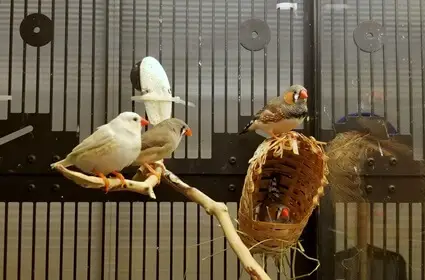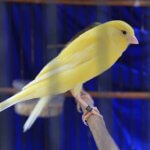Canaries and finches can usually coexist peacefully because they belong to the Fringillidae family. Even though their social structure is different, they’re small, calm, and friendly.
Canaries and finches often interact in the wild, even if they don’t live or socialize together. The same can be said of canaries and finches in captivity. Although they’re not guaranteed to be friends, with canaries being more solitary and finches requiring more social interaction, they can get along okay.
Of course, this isn’t true for all finches or canaries. There are upward of 234 species of finches and dozens of canary breeds, each with specific habits, temperaments, and needs. Docile canaries will get along with docile finches, while territorial canaries are likely to be less hospitable.
So, you need to consider which finches and canaries you’re pairing together.
What Finches Live with Canaries?
Good examples of finches that can live harmoniously with canaries include:
- Gouldian finches
- Plum-headed finches
- Society finches
- Star finches
- Double-barred finches
- Red-headed parrot finches
These varieties are calm and can be housed with canaries without infighting.
Certain varieties, such as star and society finches (Bengalese finches), are more timid than canaries. So, if you keep them together, you must monitor their interactions in the event of bullying.
Although it takes more care and supervision, it’s also possible for more domineering finch varieties to live with canaries. These include:
- Strawberry finches
- Zebra finches
- Lavender waxbills
Monitoring is especially important if you keep Zebra finches since they’re highly active and territorial.
Zebra finches regularly fight over mates, food, perches, and nesting sites. So, if you keep Zebra finches with canaries, ensure they have lots of space and resources.
What Finches Are Bad for Canaries?
Certain finch varieties are highly aggressive and should never be kept with canaries in shared cages, as they might attack them. These include:
- Parson finches
- Crimson finches
- Diamond fire-tail finches
- Bar-breasted fire finches
- Cuban melodious finches
Can Canaries And Finches Be in The Same Cage?
It’s possible to rear canaries and finches in a shared cage, but you must take precautions. Despite their shared traits, they’re still different species and have different needs.
For example, canaries prefer their privacy and space and can live alone. Meanwhile, finches are social and thrive in groups, so they’ll be active, friendly, and annoying to a more solitary bird.
To ensure each bird gets what it needs and doesn’t overwhelm the other, you must establish the right conditions to support them, individually and as a pair.
Here are factors to ensure your flock of canaries and finches thrives:
Spacious Aviary
The average cage won’t be large enough for a canary-finch pair.
Both species are active birds that love to fly around and explore their environment. More so, finches are social and will be eager to spend time around their cage mate.
If the canary doesn’t have enough space to isolate itself for private time, this can lead to fighting.
Maintaining them in a cramped enclosure will likely cause emotional distress and conflict. Therefore, consider a spacious aviary that can accommodate each bird without getting in each other’s way.
Your enclosure should be at least 47 inches wide, with 3 perches for every pair of birds.

Avoid Overcrowding
No matter how large the enclosure is or how compatible your finches and canaries are, keeping them in large crowds will likely cause squabbling, which will be a major source of stress.
While canaries do best when kept by themselves or in pairs, finches thrive best in small flocks. Therefore, you may plan on keeping several finches and a few canaries.
However, keeping your cage as sparsely populated as possible is recommended.
Multiple Feeding Stations
With finches especially, dominant birds may attempt to hoard food. Therefore, if you keep canaries and finches together, have multiple feeding stations and water dishes in the cage.
This will ensure that no one is left hungry or thirsty, and the territorial displays will be less pronounced.
Do Canaries and Finches Fight?
Canaries and finches are peaceful birds that can coexist harmoniously with their kind and similar species. If the conditions are right, there should be little fighting.
Even so, it’s possible for spats and bullying to occur, especially between males and during the breeding season. Here are ways to deal with conflicts:
Regular Monitoring
Both canaries and finches are susceptible to stress when exposed to bullying and aggression.
If this happens frequently, your birds may end up becoming depressed, which will negatively impact their physical health and overall state of well-being.
That makes it important to observe them throughout the day. Pay attention to any signs of aggressive behavior, as well as symptoms of depression, such as:
- Feather plucking
- Hiding
- Lack of hunger or thirst
- Lethargy
- Lack of singing or vocalizing
Isolate Weak or Aggressive Birds
If you have weak birds, you may need to isolate them into their cage. Fragile canaries or finches are at risk of bullying, which may worsen their state.
If one bird doesn’t get along with the others, transfer it to its cage for a few days. This prevents it from overwhelming the rest of the birds and helps it settle down, making its behavior less threatening.
Before reintegrating any bird back into the flock, consider changing the positions of feeding stations, water bowls, and perches within the cage, as this will shift the power dynamics.
Introduce The Birds In Pairs
When bringing new canaries or finches into your shared aviary, introduce them as pairs.
Don’t place a single bird into an established flock. Otherwise, the others may stake territory within the cage against the newcomer, ostracize, or attack it.
Keep the ratio of canaries and finches even so that each bird has at least one member of its species to get along with. This minimizes any chances of one species trying to dominate the other.
Match Up Birds by Size
It’s unwise to keep small and large birds together in a shared cage, regardless of species. The much larger birds are likely to dominate and bully the small ones.
Perches And Plant Cover
Both canaries and finches require perches and plant cover to roost. Offering several perches (at least one for each bird) and plant cover will help minimize disputes over the best places to sleep.
Plant cover also gives bullied birds a place to hide and escape from more aggressive flock mates until they can get used to each other.
Can Canaries and Finches Mate?
Since they’re of the same family, canaries and finches can mate with each other to produce hybrids. These are known as “mules.” According to The American Naturalist, they’re rarely fertile.
Finch varieties most successfully breed with canaries are the goldfinch and green finch. To interbreed a canary and a finch, you require a male finch and a female canary.
However, some breeders occasionally succeed in making mules from crossing male canaries and female finches. This will depend on the finch’s size and health status.








